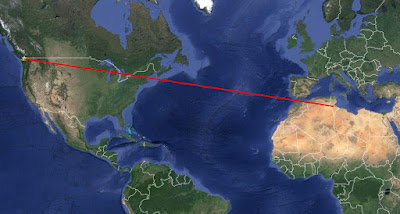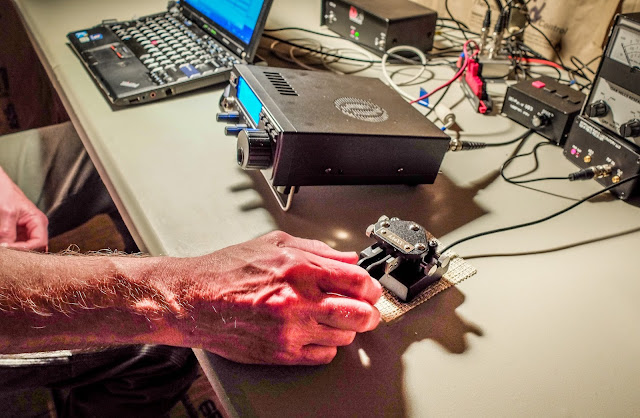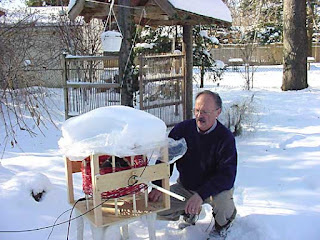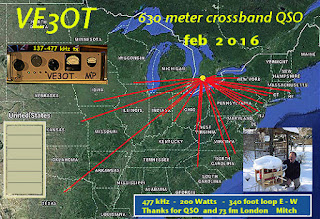Posts Tagged ‘CW’
 Seven To Go
Seven To Go

Confirmed DXCC entity #332 arrived in the mail last week. With a total of 339 active DXCC entities, this leaves just seven to go.
Although I had worked Tunisia a couple of years ago on 15m, I was never able to get the contact confirmed. In spite of sending an SAE and green stamps for postage, 3V8HQ's several promises of his card 'soon to be mailed', proved to be hollow.
The contact with 3V8HQ was my first and only one with Tunisia, since being licenced in 1963. The low level of ham radio activity from 3V8 combined with the challenges of VE7 to Meditteranean Africa propagation, made it a difficult one to work.
 |
| courtesy: https://www.google.ca/maps |
My present confirmed list sitting at 332, combined with my 10 confirmed 'deleted' entities, brings the overall confirmed total to 342. The seven remaining entities will be very difficult, if not impossible, unless I live to be 150. They are:
FT/G, TO - Glorioso
HK0 - Malpelo Island
KP5 - Desecheo Island
P5 - N. Korea
SV/A - Mt. Athos
Z8 - S. Sudan
ZL9 - Auckland / Campbell Islands
A couple of these have been active in past recent years ... for some, I was asleep at the switch and for others, I was away travelling at the time. With solar conditions heading downhill quickly, and possibly staying there for many many years, the prospects of working these last seven is looking pretty bleak.
On the other hand, my favorite winter band (160m) should continue to improve. Last week also brought a new DXCC QSL for me on that band, A35T in Tonga, bringing my confirmed total on that band to 157.
Getting new entities from here on out will be increasingly challenging ... I guess I need to remember, that if it was easy, it just wouldn't be any fun!
 A visit with a QRP contest station
A visit with a QRP contest station
160m Spring Stew Perry Contest - QRP style
I had the opportunity to visit with Paul Stroud AA4XX as he worked the early hours in the 160m Spring Stew Perry Contest. Paul is an avid CW operator dedicated to QRP and QRPp operations. When he works contests he often participates using the Knightlites club call WQ4RP (Note the QRP in the call). |
| AA4XX operating as WQ4RP during the 160m Stew Perry Spring Top Band contest |
160m Top Band
160m (top band) is challenging due to the physical logistics of a suitable antenna. I had the opportunity to assist with a portion of raising the 160m vertical loop antenna at the "Excalibur antenna site" and installing the 24 elevated radials that help make this antenna so effective. There's a lot of wire in the ground system. The antenna site is located in the woods, off grid, and away from electrically noisy homes.Power to the remote shack is supplied by a quiet Honda 1kW generator operating a couple dozen feet from the shack. Due to the lower power requirements of QRP Paul can run the generator on eco-mode allowing its small fuel tank to provide 8 hours of operation between fill-ups.
Paul uses a Ten Tec Argonaut VI, running 5 watts output into the Excalibur 160m vertical loop. He uses N1MM+ logger software and a WinKeyer interfaced to the software. He also employs a SDR (software defined radio) feeding CWSkimmer signals across the band. An antenna splitter simultaneously feeds the SDR and the Argonaut. The SDR receiver is switched out during transmit by a DX Engineering RTR-1A Receive switch. His CW key is a N3ZN ZN-QRP model.
The N1MM+ logging software keeps track of which stations have already been worked and the CWSkimmer interface displays calling stations on the band being heard by his antenna.
 |
| The remote QRP station setup for contesting |
In the Stew Perry contest the only information exchanged was grid squares. I'm still relatively new to CW and watching Paul casually copy grid squares sent at 30wpm was impressive. I would have had to ask the caller to re-send their grid squares 5 times but Paul makes it look easy.
Instructions for the newbie
 |
| Paul demonstrating the contesting software and usage |
Why QRP?
 |
| Finding the next station to work. (N3ZN QRP CW key in the foreground) |
Why contest?
What's next?
 Just One More db …
Just One More db …

How often have you struggled to pull a weak signal out of the noise? "Just give me one more db", you tell yourself.
A recent posting to the Topband reflector by Frank, W3LPL, sent me to the interesting webpage of Dave, AB7E. Dave had been pondering two antenna systems, one of which would provide a 2db improvement in forward gain but at a much higher cost ... he wondered if the extra expense would be worthwhile and could he even hear the difference that 2db would make? He created a series of CW files, incrementing the signal level in 1db steps to see for himself!
Now I've always been told that you need to increase signal strength by at least 3db before your ears can detect any difference ... but listen carefully and you may be in for a surprise, as AB7E discovered.
It's probably best to listen to this signal with headphones but, even on my I-Pad's tiny speaker, the demonstration is clear. The first recording starts at "zero db", which is sent twice while the next signal is "one db", sent twice. See if you can hear the difference between each 1 db increment as he steps up to "six db":
Try going the other way, from "six db" down to "zero db":
The following recording has two signals, one of which is one db louder then the other. Can you hear the difference?
Although I was able to hear one call slightly better than the other, it was difficult. How about two signals again, one of them being 2db louder this time ... this one is much easier:
Lastly, AB7E demonstrates the problem with sending too fast when conditions are very marginal. Here, several signals are sent at 20, 25, 30 and 35 WPM. Sending calls at high speed can often seem effective, even under poor conditions but this seems to demonstrate that slowing down just a bit would make it somewhat easier:
One of the more interesting comments posted regarding these recordings was from Bob, N6RW who cited his work in satellite communications:
"I spent part of my engineering career designing satellite command FSK
demodulators - including the deep space Pioneer Venus orbiter. To test
the performance of them, we would mix the test signal with white noise.
When you look at the FSK Bit-Error-Rate (BER) curve (bit errors versus
signal to noise ratio in a bandwidth equal to the bit rate), you can see
the BER improves by a factor of 10 to 1 for every dB in S/N ratio. In
other words, for every dB improvement, you get one tenth the errors."
Now Dave never did tell us if he bought the bigger antenna or not but I'm betting that he did ... it looks like "just one more db" may really be just enough after all.
 How-To: Send Perfect Morse Code by Hand (Vintage Video)
How-To: Send Perfect Morse Code by Hand (Vintage Video)
What is the proper (and most efficient) technique for creating Morse code by hand, using a manual Morse code key? Ham radio operators find Morse code (and the ‘CW’ mode, or ‘Continuous Wave’ keying mode) very useful, even though Morse code is no longer required as part of the licensing process. Morse code is highly effective in weak-signal radio work. And, preppers love Morse code because it is the most efficient way to communicate when there is a major disaster that could wipe out the communications infrastructure.
While this military film is antique, the vintage information is timeless, as the material is applicable to Morse code, even today.
More about Morse code, at my website: http://cw.hfradio.org
Thank you for watching, commenting, and most of all, for subscribing. By subscribing, you will be kept in the loop for new videos and more… my YouTube Channel: https://YouTube.com/NW7US
See my Video Playlist for related Morse code vidoes:
 The VE3OT 630m Beacon
The VE3OT 630m Beacon

I suspect there are probably a lot of Canadian amateurs still thinking that our new 630m is not very practical for anything other than local two-way contacts.
During the winter 'DX season', this is definitely not the case, as 630m shares many, if not all, of the propagation characteristics found in the lower end of our AM broadcast band. As well, a quick tune through the even lower NDB band on a normal night will reveal dozens of 25-watters, often from over a thousand miles away and with very robust signals.
With no 630m amateur activity yet coming from VE6, VE5 or VE4, it is difficult to get a sense of just how interesting the band could become on these normal nights, or how great it would be on a really good night of propagation. My recent CW contact with the nearest out of province station, VE3OT (Mitch), on a normal night, demonstrates that there is a lot of potential for some really effective two-way work over long distances.
So ... what do signals sound like between here and Ontario? Here is Mitch's CW beacon as heard here on the evening of February 11th, at around 2300 hours local time, using my 10' x 20' loop. I have heard Mitch at even higher levels than this, but his beacon is usually audible here on most undisturbed nights, sometimes as early as 2000 hours local time. His beacon signal runs 200 watts to a 340' circumference loop, from his London, Ontario, suburban backyard.
Even if you are not able to hear Mitch's signal audibly, it should be fairly easy to copy in one of the QRSS CW modes, such as QRSS3 or QRSS10 ... both of which could yield a reasonably quick two-way contact.
Judging from the reliability of the VE3 signal, any activity from the prairie provinces should be even easier to hear. Should any of you in the prairies take up the 630m challenge, I can assure you that you'll be very, very popular out west ... every night!
This blog also provides an opportunity for my initial use of the 'tunestotube' web site. It provides a nice online interface for posting audio files to Youtube, along with an image, or a slideshow. It seemed to work seamlessly and will save me having to link to audio files stored on my own web site, which really eat up what little space I have left.
 speed = distance over time
speed = distance over time
Speed does = distance over time. In terms of CW my speed is currently around 12wpm with a character speed of around 20wpm. I have been at a distance from a qso for over a month now and I am experiencing what is called a plateau. Or is this my natural speed?
If I go for a run, I know I can run at a certain pace for a certain distance. Nowadays no amount of training will get me down to what I could once do when I was in my teens (back then I could do around 1 to 2 minutes quicker for a mile). This was the same back then. I have a capacity and I know it well. Is the same true for CW?
Can I only do a certain speed?
How do I find a natural speed and maintain it? (Overtraining is a crime!)
My normal excuse is I need a new pair of trainers. Surely I need a new morse key, right?
 Trans-Canada On 630m
Trans-Canada On 630m
 |
| courtesy: http://www.bing.com/mapspreview |
Both Mitch and myself had been alerted to the excellent propagation earlier in the week, when VE3OT's CW beacon had reached S9 levels here for several hours on two consecutive nights ... but any late-night QSO attempts would have to wait until the weekend, when having to get up in the middle of the night would not conflict with Mitch's workweek schedule.
Our first attempt, late on Friday night and 3A.M. for Mitch, found that conditions had deteriorated from midweek's enhanced propagation and the low signal levels, combined with some unseasonal lightning noise, resulted in rescheduling for another shot on Saturday.
Late Saturday night found the band much quieter and propagation much improved, but not as good as it had been earlier in the week ... somehow Murphy always seems to have a hand in pre-planned events, and it's never a helpful one. Mitch's beacon signal was readable here but had a deep ten-minute fade cycle with a short-lived peak before fading out to nothing.
 |
| VE3OT at his loop's loading coil |
 |
| LF / MF station at VE3OT |
For those of you that worked VE3OT during the recent 630m crossband event, Mitch has put together a very special QSL card!
As the solar cycle winds down, the 'good' nights will happen more often, as will the truly 'great' nights. Hopefully there will be more Canadians on the band to take advantage of what lies ahead.
Hopefully the U.S.A. will soon have the band as well, which will really spark nightly activity. What is really needed right now is more Canadian activity, especially in the western provinces, where nightly CW contacts could be readily made. Time to reach for the solder iron! There are several VE7's, and one VE3, waiting and wanting to work you!
















